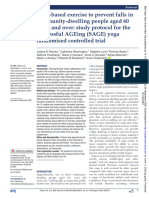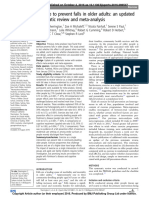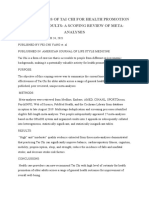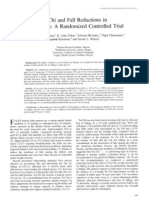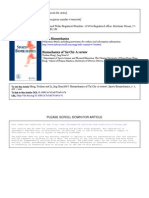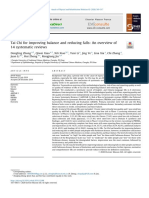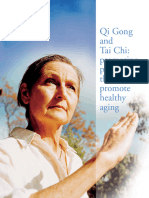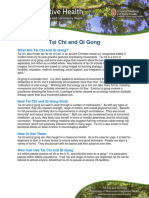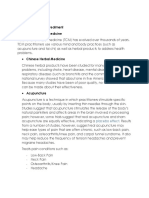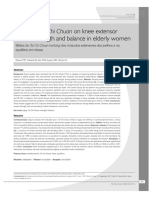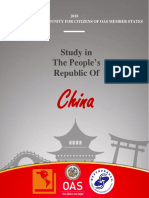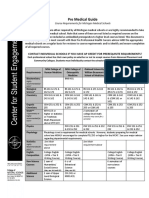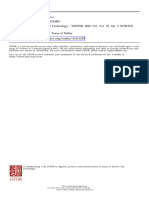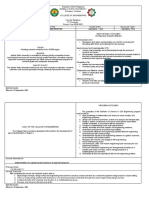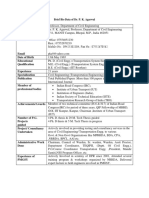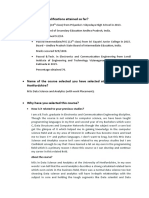Revisión Sistemática
Uploaded by
r0ssumRevisión Sistemática
Uploaded by
r0ssumDownloaded from http://bmjopen.bmj.com/ on May 20, 2017 - Published by group.bmj.
com
Open Access Research
Systematic review and meta-analysis:
Tai Chi for preventing falls in older
adults
Zhi-Guan Huang,1 Yun-Hui Feng,2 Yu-He Li,1 Chang-Sheng Lv1
To cite: Huang Z-G, Feng Y- ABSTRACT
H, Li Y-H, et al. Systematic Strengths and limitations of this study
Objective: It remains unclear whether Tai Chi is
review and meta-analysis: Tai
effective for preventing falls in older adults. We This study is, to date, the most comprehensive
Chi for preventing falls in
older adults. BMJ Open
undertook this systematic review to evaluate the systematic review evaluating Tai Chi for prevent-
2017;7:e013661. preventive effect of Tai Chi by updating the latest trial ing falls in older adults. A number of recently
doi:10.1136/bmjopen-2016- evidence. published trials were included, which improved
013661 Design: Systematic review and meta-analysis. the precision of the estimated effects and
Methods: The Cochrane Library, MEDLINE and enabled us to investigate various influential
Prepublication history and EMBASE were searched up to February 2016 to factors such as Tai Chi style and frequency.
additional material is identify randomised trials evaluating Tai Chi for Our confidence in the findings is further
available. To view please visit preventing falls in older adults. We evaluated the risk increased by significant doseresponse effect,
the journal (http://dx.doi.org/ of bias of included trials using the Cochrane stable sensitivity analyses and stable analyses by
10.1136/bmjopen-2016- Collaborations tool. Results were combined using adjusting for publication bias.
013661). random effects meta-analysis. The findings are likely to be influenced due to
Outcome measures: Number of fallers and rate of the bias in some original trials.
falls. The estimated preventive effect of Tai Chi may be
Received 1 August 2016
Results: 18 trials with 3824 participants were overestimated due to publication bias.
Revised 21 November 2016
Accepted 9 December 2016 included. The Tai Chi group was associated with
significantly lower chance of falling at least once (risk
ratio (RR) 0.80, 95% CI 0.72 to 0.88) and rate of falls medical resources consumptions.3 4
(incidence rate ratio (IRR) 0.69, 95% CI 0.60 to 0.80) Fall-related complications are the leading
than the control group. Subgroup analyses suggested cause of unintentional injury deaths in
that the preventive effect was likely to increase with people over 65 and the fth leading cause of
exercise frequency (number of fallers: p=0.001; rate of death.5 6
falls: p=0.007) and Yang style Tai Chi was likely to be A number of interventions, including
more effective than Sun style Tai Chi (number of adaptation and modication of home envir-
fallers: p=0.01; rate of falls: p=0.001). The results onment, exercise, medication modication
might be influenced by publication bias as the funnel
and vitamin D supplementation, have been
plots showed asymmetry. Sensitivity analyses by
applied for preventing falls.79 Tai Chi is a
sample size, risk of bias and comorbidity showed no
major influence on the primary results. traditional systematic calisthenics exercise
Conclusions: Tai Chi is effective for preventing falls in widely practiced in China. Tai Chi has been
older adults. The preventive effect is likely to increase shown to be effective in improving balance,
1
with exercise frequency and Yang style Tai Chi seems proprioception, muscle strength and endur-
Engineering Research Center ance,10 11 therefore it may be benecial for
to be more effective than Sun style Tai Chi.
for Sports Assistive Devices
Design, Guangzhou Sport
preventing falls among the elderly. To date,
University, Guangzhou, the preventive effect of Tai Chi has been
Peoples Republic of China INTRODUCTION evaluated by a number of randomised con-
2
Department of Physical Falls are common among older adults and trolled trials (RCTs); however, their ndings
Education, School of Physical are one of the major threats to their health. were inconsistent.1215 Although some
Education and Sports
Science, Guangzhou
The incidence of falls varies with living status authors have synthesised the results of the
University, Guangzhou, and increases with age; in general popula- related original trials,1618 these secondary
Peoples Republic of China tion, 3040% people over 65 years fall every studies might miss some trials and some
year worldwide, increasing to 50% among recently published RCTs were not included.
Correspondence to
people aged 80 years and older.1 2 Falls in Moreover, the preventive effect of Tai Chi
Professor Yu-He Li;
yuheli2000@163.com
older people are associated with considerable may vary with Tai Chi style, exercise dose,
Professor Yun-Hui Feng; subsequent decline in functional status and exercise duration and time of follow-up, but
932832207@qq.com increase in nursing home admissions and the preventive effect in these subgroups was
Huang Z-G, et al. BMJ Open 2017;7:e013661. doi:10.1136/bmjopen-2016-013661 1
Downloaded from http://bmjopen.bmj.com/ on May 20, 2017 - Published by group.bmj.com
Open Access
unclear. The primary aim of this study was to evaluate drinking, smoking, overall health status, use of walking
the effect of Tai Chi for preventing falls in older adults aid and comorbidity), interventions and comparisons
by updating the latest trial evidence. The secondary aim (type of Tai Chi, exercise intensity, duration and fre-
was to explore the association between the effectiveness quency), outcomes (number of fallers and rate of falls)
and potential inuential factors including Tai Chi fre- and study methods (study design, random sequence gen-
quency, total exercise time, follow-up time, falling risk at eration, allocation concealment, methods for dealing
enrolment and type of Tai Chi. with missing data, selective reporting and other methodo-
logical issues). We contacted the authors of original
studies to collect missing information when necessary.
METHODS The risk of bias of included RCTs was evaluated using the
Criteria for study inclusion Cochrane Collaborations tool for assessing risk of bias.19
This systematic review included RCTs evaluating the
effect of Tai Chi exercise in people aged over 60 years. A
trial was eligible if the age of participants was not Data analysis
We pooled data with a random effects model which
limited, but the average age was over 65 years. The parti-
cipants in the control group may receive usual care, accounts for within and between-study variability to
stretching or other low-level exercises, education or provide more conservative estimates. RR, together with
standard lifestyle modication. The follow-up time of eli- the corresponding 95% CI, was used as the summary
gible study should be 4 weeks or longer. Additionally, eli- effect measure for the number of fallers. We used IRR
gible studies should report at least one study outcome of to compare the rate of falls.
this systematic review. The primary outcome for this We evaluated the heterogeneity among studies with
study was the number of fallers (the participants who the Q-test and the I2-index statistic. A value for I2 >50%
fell at least once). Rate of falls (the number of falls per accompanied by p<0.10 for the Q-test was regarded as
person-year) was considered as the secondary outcome. being indicative of moderate to high level of heterogen-
eity.19 We carried out subgroup analyses to evaluate the
estimated effect in specic subgroups and to evaluate
Literature search and study selection potential interactions. Subgroup analyses were carried
An electronic search of Cochrane Library (Issue 2, 2016), out according to Tai Chi frequency (once, twice, three
MEDLINE (1966 to 1 February 2016) and EMBASE (1984
times and more than three times per week), total Tai
to 1 February 2016) was performed to identify potentially Chi exercise time (30 hours, >30 and 60 hours and
eligible trials. The search strategy included terms for Tai >60 hours), time of follow-up (>1 and 3 months, >3
Chi, falls and a lter for RCTs using the following combined
and 6 months, and >6 months), falling risk at enrol-
text and MeSH terms: Tai Chi, falls, accidents, and ran- ment (low and high) and type of Tai Chi exercise (Yang
domized controlled trial (for full search strategy, see style Tai Chi and Sun style Tai Chi).
online supplementary table S1). All searches were restricted
For each outcome, we used funnel plot to examine
to human studies, and there was no limitation on language the publication bias if the number of original trials
and publication status. We searched the MetaRegister of included in the meta-analysis was 10. The symmetry of
Controlled Trials and the WHO International Clinical Trials
the funnel plots was assessed by Eggers test.19 20 When
Registry Platform for ongoing studies. The reference lists of the funnel plot showed asymmetry, we used trim and ll
the included studies and related review articles were method to adjust for publication bias in meta-analysis.21
screened to identify additional studies.
Moreover, we undertook sensitivity analyses according to
We input the records from electronic databases into sample size (excluding studies with sample size <100 par-
database management software, and the duplicate cita- ticipants), risk of bias (excluding studies with high risk
tions were removed. Two authors (Z-GH and Y-HF) then
of bias in one or more domains, or with unclear risk of
independently evaluated the eligibility of the remaining bias in more than three domains, according to the
citations by examining the titles, abstracts and full arti- assessment results in online supplementary table S2)
cles sequentially. Discrepancies were resolved by
and comorbidity (excluding studies which included
discussion. patients with stroke and Parkinsons disease). Data ana-
lyses were performed using Cochrane Collaboration
Data extraction and risk of bias review manager software (RevMan V.5.1) and STATA V.12
Two investigators (Z-GH and C-SL) independently (StataCorp, College Station, Texas, USA).
extracted data from eligible studies and evaluated the risk
of bias; the investigators were not blinded. Disagreements
were resolved by discussion between the two investigators RESULTS
until a consensus was achieved. The extracted data Study characteristics and risk of bias
included study characteristics (ie, title, authors, location, The electronic search and search for additional
publication date, number of participants, setting and resources totally identied 227 potentially eligible cita-
study duration), patient characteristics (ie, age, gender, tions, of which 177 were excluded after removing dupli-
previous falling history, marriage, education, living status, cates and screening the titles and abstracts. The full
2 Huang Z-G, et al. BMJ Open 2017;7:e013661. doi:10.1136/bmjopen-2016-013661
Downloaded from http://bmjopen.bmj.com/ on May 20, 2017 - Published by group.bmj.com
Open Access
23 24 2629 33 35
texts of the 50 remaining records were screened, and and 14 trials,1215 23 24 2628 30 3235
nally, 18 studies including 3824 participants were respectively. The detailed assessment of risk of bias was
included (gure 1).1215 2235 presented in online supplementary table S2.
Table 1 presents the characteristics of included
studies. Seven included studies were carried out in the
USA,14 15 22 27 29 31 34 three in China,13 24 35 two in Number of fallers
Taiwan,25 26 two in Australia,23 33 two in Sixteen studies (3539 participants) were included in the
Netherlands,12 28 one in New Zealand30 and one in meta-analysis of the number of fallers (gure 2). The
Canada.32 Most studies recruited participants from the chance of falling at least once was signicantly lower in
community except for the study by Gao et al,24 which the Tai Chi group than the control group (RR 0.80, 95%
recruited participants from hospital and community. CI 0.72 to 0.88; heterogeneity: p=0.1, I2=32%). Overall,
Three studies were undertaken in frail and prefrail older 10 (95% CI 7 to 17) older adults would need to take Tai
adults,12 32 34 two studies in patients with stroke,15 31 two Chi exercise to avoid one fall.
in patients with Parkinsons disease,24 27 one in postme- In the subgroup analysis by Tai Chi exercise fre-
nopausal women with osteopenia22 and the other quency, total Tai Chi exercise time, time of follow-up,
studies did not limit the comorbidity or health status of baseline falling risk and the style of Tai Chi, the chance
participants and the participants were not restricted to of falling at least once was still lower in the Tai Chi
adults at risk of fall. group compared to the control group. Owing to
The risk of bias of included studies was unclear or low. reduced sample size, the RRs in some subgroups were
Fifteen1215 2224 2633 and 13 trials1215 22 23 26 27 2933 not signicant (table 2). The reduction in the risk
were considered at low risk in terms of random seems to be larger in participants taking Yang style Tai
sequence generation and allocation concealment, Chi (RR 0.61, 95% CI 0.46 to 0.80) than Sun style Tai
respectively. Blinding of participants and personnel was Chi (RR 0.88, 95% CI 0.80 to 0.98) (test for subgroup
adequate in seven studies,12 27 28 30 3234 and blinding of difference: p=0.01). Moreover, the effect size of Tai Chi
outcome assessment was adequate in 14 seems to increase with exercise frequency ( p=0.001),
studies.12 14 15 2224 2628 3034 The risk of incomplete from an RR of 0.95 for once a week to 0.36 for >3 times
outcome data and selective reporting was low in 131215 a week.
Figure 1 Flow chart of study
selection.
Huang Z-G, et al. BMJ Open 2017;7:e013661. doi:10.1136/bmjopen-2016-013661 3
Downloaded from http://bmjopen.bmj.com/ on May 20, 2017 - Published by group.bmj.com
Open Access
Table 1 Characteristics of included studies (arranged in order by publication time)
Mean Falling
age. Sex, history, n Follow-up
Study Intervention and control (n) Tai Chi intensity year F/M (%) time
Nowalk Living and learning/Tai Chi (38) Three times per week 82.8 8/30 24 months
200129 Basic enhanced programme (35) for 24 months 85.9 5/30
Wolf 200334 Tai Chi (145) Twice a week for 80.9 137/8 48 weeks
Wellness education (141) 48 weeks 80.8 132/9
Li 200514 Yang-style Tai Chi (125) Three sessions per 76.9 87/38 6 months
Stretching (131) week for 26 weeks 78 92/39
Faber 200612 Tai Chi (80) Once a week for 84.8 61/19 16 weeks
Control, the participants were 4 weeks, followed by 85.4 53/13
asked not to change their usual twice weekly for
pattern of activities (66) 16 weeks
Voukelatos Sun or Yang-style Tai Chi (353) Once a week for 69 300/ 109 (31%) 16 weeks
200733 16 weeks 53
No Tai Chi (349) 69 290/ 126 (36%)
59
Woo 200713 Yang-style Tai Chi (60) Three times per week 68.9 30/30 12 months
No Tai Chi (60) for 12 months 68.6 30/30
Logghe Yang-style Tai Chi (138) Twice a week for 77.5 96/42 88 (63.8%) 12 months
200928 Usual care (131) 13 weeks 76.8 95/36 79 (60.3%)
Zeng 200935 Yang-style Tai Chi (63) Three times a week 98/26 11(17.4%) 2 years
No Tai Chi (61) for 2 years 12(19.7%)
Chyu 201022 Yang-style Tai Chi (31) Once a week for 72.4 31/0 24 weeks
No Tai Chi exercise (31) 24 weeks 71.3 31/0
Huang Tai Chi (31) Three sessions per 71.4 9/22 1 year
201025 No Tai Chi (47) week for over 5 months 71.5 19/28
Huang Yang-style Tai Chi (62) Five times a week for 40/22 12 (10%) 6 months
201126 No Tai Chi (62) 8 weeks 35/27 12 (12%)
Li 201227 Tai Chi (65) Twice a week for 68 20/45 24 weeks
Low-intensity exercise (65) 24 weeks 69 26/65
Taylor Sun-style Tai Chi (233) Once/twice a week for 75.3 161/ 137 (60%) 20 weeks
2012a30 20 weeks 72
Sun-style Tai Chi (220) 74.4 165/ 119 (56%)
55
Low-level exercise (231) 73.7 176/ 137 (61%)
55
Taylor Yang-style Tai Chi (16) Three sessions per 72.8 6/10 12 weeks
201231 Usual care (12) week for 12 weeks 64.5 5/7
Tousignant Tai Chi (76) Twice a week for 79.1 57/19 76 (100%) 12 months
201332 Conventional physical therapy (76) 15 weeks 80.7 54/22 76 (100%)
Gao 201424 Yang-style Tai Chi+usual care (40) Three sessions per 69.5 14/23 12 months
Usual care (40) week for 12 weeks 68.3 12/27
Taylor Yang-style Tai Chi (53) Three sessions per 71.5 19/34 12 weeks
201415 Usual community-based exercise week for 12 weeks 68.2 25/23
(48)
Day 201523 Sun-style Tai Chi (205) Twice a week for 77.6 142/ 59 (28.9%) 48 weeks
48 weeks 62
Stretching (204) 77.8 143/ 61 (29.8%)
62
Rate of falls in various subgroups, though the IRRs might not always
Fifteen studies including 3470 events contributed to the be signicant as the sample sizes were reduced (table 2).
meta-analysis of the rate of falls (gure 3). Tai Chi exer- Like the subgroup analyses for the number of fallers,
cise signicantly reduced the rate of falls compared to subgroup analyses suggested that the size of estimated
the control (IRR 0.69, 95% CI 0.60 to 0.80; heterogen- preventive effect in the Yang style Tai Chi group was
eity: p=0.003, I2=57%). The participants in the Tai Chi larger than that in the Sun style Tai Chi group
group were generally associated with lower rate of falls ( p=0.001), and increased with Tai Chi exercise
4 Huang Z-G, et al. BMJ Open 2017;7:e013661. doi:10.1136/bmjopen-2016-013661
Downloaded from http://bmjopen.bmj.com/ on May 20, 2017 - Published by group.bmj.com
Open Access
Figure 2 Meta-analysis of the number of fallers between the Tai Chi group and the control group.
Table 2 Subgroup analyses of the effect of Tai Chi for preventing falls in older adults
Number of fallers Rate of falls
Subgroup Studies Participants RR (95% CI) Studies Falls IRR (95% CI)
The style of Tai Chi
Yang style 71315 24 26 28 35 943 0.61 (0.46 to 0.80) 81315 22 24 26 28 35
528 0.54 (0.42 to 0.70)
Tai Chi
Sun style Tai 323 30 33 1777 0.88 (0.80, 0.98) 323 30 33
1684 0.91 (0.75 to 1.11)
Chi
Test for subgroup differences: p=0.01 Test for subgroup differences: p=0.001
Tai Chi frequency
Once a week 312 30 33 1316 0.95 (0.84 to 1.07) 412 22 30 33 1294 0.84 (0.63 to 1.13)
Twice a week 623 27 28 30 32 34 1638 0.83 (0.76 to 0.92) 623 27 28 30 32 34
1641 0.73 (0.57 to 0.95)
Three times a 61315 24 25 29 584 0.62 (0.51 to 0.75) 41315 24 454 0,48 (0.36 to 0.64)
week
>Three times 226 35 232 0.36 (0.13 to 0.98) 226 35
81 0.38 (0.18 to 0.65)
a week
Test for subgroup differences: p=0.001 Test for subgroup differences: p=0.07
Total exercise time
30 hours 524 28 30 32 33 1586 0.85 (0.73 to 0.99) 524 28 30 32 33
1498 0.84 (0.67 to 1.07)
>30 and 60 612 25 26 28 30 32 984 0.81 (0.65 to 1.00) 512 24 28 30 32
1138 0.58 (0.35 to 0.94)
hours
>60 hours 414 23 34 35 1007 0.80 (0.67 to 0.94) 514 22 23 34 35 437 0.64 (0.49, to0.84)
Test for subgroup differences: p=0.82 Test for subgroup differences: p=0.20
Time of follow-up
>1 and 415 24 26 33 926 0.63 (0.44 to 0.89) 515 24 26 27 33
478 0.46 (0.30 to 0.69)
3 months
>3 and 414 23 27 33 1411 0.79 (0.65 to 0.94) 414 23 27 33
633 0.67 (0.52 to 0.86)
6 months
>6 and 1012 13 23 25 2830 2526 0.85 (0.78 to 0.93) 812 13 23 28 30 32 34 35
2633 0.85 (0.73 to 0.98)
12 months 32 34 35
Test for subgroup differences: p=0.23 Test for subgroup differences: p=0.01
Falling risk at enrolment
High 424 28 30 32 1122 0.83 (0.70 to 0.98) 424 28 30 32 1934 0.90 (0.75 to 1.07)
Low 121215 23 2527 2417 0.78 (0.68 to 0.89) 111215 23 26 27 29
1536 0.62 (0.50 to 0.76)
29 3335 3335
Test for subgroup differences: p=0.57 Test for subgroup differences: p=0.02
IRR, incidence rate ratio; RR, risk ratio.
Huang Z-G, et al. BMJ Open 2017;7:e013661. doi:10.1136/bmjopen-2016-013661 5
Downloaded from http://bmjopen.bmj.com/ on May 20, 2017 - Published by group.bmj.com
Open Access
Figure 3 Meta-analysis of the rate of falls between the Tai Chi group and the control group. IRR, incidence rate ratio.
Figure 4 Evaluation of publication bias. RR, risk ratio; IRR, incidence rate ratio. The funnel plots showed asymmetry (there
were no dots in the lower-right corner, which stand for small studies with small or negative effect), suggesting that the results
were likely to be overestimated.
frequency ( p=0.007). Moreover, the preventive effect of not show any major inuence on the primary
Tai Chi was likely to reduce with follow-up time meta-analysis results (table 3).
( p=0.002) and in participants with higher falling risk
( p=0.02).
DISCUSSION
Though a number of original trials and secondary
Reporting bias and sensitivity analyses studies have been performed to investigate the effect of
Funnel plots (gure 4) and Eggers tests (number of Tai Chi for preventing falls in older adults, the evidence
fallers: p=0.005; rate of falls: p<0.001) suggested that the remains controversial. On the basis of 18 RCTs including
meta-analyses were likely to be inuenced by publication 3824 participants, this systematic review indicated that
bias. We used the trim and ll method to adjust publica- Tai Chi signicantly reduced the number of fallers (by
tion bias. However, no study was trimmed and the com- 20%) and the rate of falls (by 31%). In addition, the
bined results were unchanged, suggesting that the effect of Yang style Tai Chi versus control was likely to be
weighting of the small studies with large effect was very larger than the effect of Sun style Tai Chi versus control.
low and the potential inuence was minor. Sensitivity Moreover, the preventive effect of Tai Chi was likely to
analyses by sample size, risk of bias and comorbidity did increase with exercise frequency.
6 Huang Z-G, et al. BMJ Open 2017;7:e013661. doi:10.1136/bmjopen-2016-013661
Downloaded from http://bmjopen.bmj.com/ on May 20, 2017 - Published by group.bmj.com
Open Access
Table 3 Sensitivity analyses by sample size, risk of bias and comorbidity
Study removed from Number of
the primary meta-analysis included studies RR/IRR (95% CI) Heterogeneity*
Sample size
Number of fallers 522 24 25 29 30
11 0.83 (0.74 to 0.93) p=0.12; I2=35%
Rate of falls 422 24 25 30
11 0.69 (0.57 to 0.83) p=0.003; I2=62%
Risk of bias
Number of fallers 625 29 30 32 34 35
10 0.76 (0.64 to 0.90) p=0.02; I2=54%
Rate of falls 525 30 32 34 35
10 0.65 (0.53 to 0.81) p=0.007 ; I2=60%
Comorbidity
Number of fallers 414 15 24 31
12 0.83 (0.74 to 0.92) p=0.27; I2=18%
Rate of falls 414 15 24 31
11 0.72 (0.61 to 0.85) p=0.02; I2=54%
*The results of statistical test for heterogeneity include Q-test (p values in this column) and the I2-index statistic (I2 values in this column).
IRR, incidence rate ratio; RR, risk ratio.
A previous meta-analysis of 13 RCTs have indicated that It should be noticed that the results are likely to be
Tai Chi was effective in improving balance and reducing inuenced due the potential bias in some original trials.
falls in the non-frail elderly.17 The nding was consistent Like many other trials evaluating exercise intervention,
with a recently published meta-analysis of six trials, which blinding of participants was hard to implement; however,
excluded the studies recruiting participants who had a the potential inuence would be minor as the end points
degenerative neurological condition, severe arthritis or of this systematic review was unlikely to be affected. The
marked vision impairments.18 To the contrary, the study by sensitivity analyses by the risk of bias also showed no
Logghe and colleagues suggested that there was insufcient major inuence to the primary analysis results. In add-
evidence that Tai Chi reduced the incidence of falls.16 A ition, clinical heterogeneity in comorbidity, living status,
possible explanation is that some recently published education status, alcohol consumption and use of walking
trials15 23 24 27 3032 were not included so the power of the aids may affect the meta-analysis results, but we were
test was low. Compared with previous meta-analyses, the unable to investigate these factors as individual patient
present study did not limit the comorbidity of participants, data were not available. Finally, the estimated preventive
included recently published trials and investigated various effect of Tai Chi may be overestimated due to publication
factors that may inuence the preventive effect, therefore bias. However, we adjusted the meta-analyses by the trim
provided more comprehensive evidence for practice. and ll method and the results were not changed, sug-
To date few studies have been carried out to investi- gesting that the potential inuence was minor. This was
gate the intensity of Tai Chi and the preventive effect. In conrmed by the sensitivity analyses by removing the
the study by Taylor et al,30 Tai Chi once a week and twice studies with a sample size <100.
a week was compared with low-level exercise for Overall, Tai Chi exercise is effective for preventing
20 weeks; the results suggested that the number of falls in older adults. The preventive effect seems to
fallers was relatively lower in the twice per week group increase with exercise frequency, and Yang style Tai Chi
(53.4%) than the once per week group (59.5%) though seems to be more effective than Sun style Tai Chi,
the difference was not signicant. Though based on sub- though direct comparisons are lacking. Future studies
group analyses which may be confounded with other are required to investigate the most effective intensity
study-level factors, our results showed a clear trend that and style of Tai Chi exercise and to assess the effect in
increase in Tai Chi exercise frequency was associated older adults with certain comorbidities, such as stroke
with a signicant increase in the preventive effect, in and Parkinsons disease.
terms of number of fallers and rate of falls.
An important strength of this study is that a compre- Contributors Y-HF and Y-HL contributed to conception and design and
hensive literature search was performed and many manuscript revision. Z-GH and Y-HF contributed to selection and screening of
trials included in this meta-analysis. Z-GH and C-SL contributed to data
recently published trials were included.15 23 24 31 32 extraction and risk of bias assessment. Z-GH, C-SL and Y-HL contributed to
These studies greatly improved the precision of the esti- data analysis. Z-GH and C-SL involved in writing of the paper.
mated effect and enabled us to investigate various inu-
Funding This study was funded by Guangdong Outstanding Young Teacher
ential factors like Tai Chi style and frequency. In Training Program in Higher School (YQ2015104) and Science and
addition, for all the prespecied sensitivity analyses, the Technology Plan Projects of Guangdong Province (2013B031600004).
results had very small difference as compared with the Competing interests None declared.
primary results, indicating that the primary results were
robust and further actions to resolve the difference was Provenance and peer review Not commissioned; externally peer reviewed.
not needed. Our condence in the ndings is further Data sharing statement No additional data are available.
increased by signicant doseresponse effect and stable Open Access This is an Open Access article distributed in accordance with
analyses by adjusting for publication bias. the Creative Commons Attribution Non Commercial (CC BY-NC 4.0) license,
Huang Z-G, et al. BMJ Open 2017;7:e013661. doi:10.1136/bmjopen-2016-013661 7
Downloaded from http://bmjopen.bmj.com/ on May 20, 2017 - Published by group.bmj.com
Open Access
which permits others to distribute, remix, adapt, build upon this work non- 18. Yuan Z, Yan W. Tai Chi as an intervention to reduce falls and
commercially, and license their derivative works on different terms, provided improve balance function in the elderly: a meta-analysis of
the original work is properly cited and the use is non-commercial. See: http:// randomized controlled trials. Chin Nurs Res 2016;3:2833.
19. Higgins J, Green S. Cochrane handbook for systematic reviews of
creativecommons.org/licenses/by-nc/4.0/ interventions Version 5.1.0 (updated March 2011). The Cochrane
Collaboration, 2011. http://www.cochrane-handbook.org.
20. Egger M, Davey Smith G, Schneider M, et al. Bias in meta-analysis
detected by a simple, graphical test. BMJ 1997;315:62934.
REFERENCES 21. Duval S, Tweedie R. Trim and fill: a simple funnel-plot-based
1. Rubenstein LZ. Falls in older people: epidemiology, risk factors and method of testing and adjusting for publication bias in meta-analysis.
strategies for prevention. Age Ageing 2006;35(Suppl 2):ii3741. Biometrics 2000;56:45563.
2. Rubenstein LZ, Josephson KR. The epidemiology of falls and 22. Chyu MC, James CR, Sawyer SF, et al. Effects of Tai Chi exercise
syncope. Clin Geriatr Med 2002;18:14158. on posturography, gait, physical function and quality of life in
3. Gill TM, Murphy TE, Gahbauer EA, et al. Association of injurious postmenopausal women with osteopaenia: a randomized clinical
falls with disability outcomes and nursing home admissions in study. Clin Rehabil 2010;24:108090.
community-living older persons. Am J Epidemiol 2013;178:41825. 23. Day L, Hill KD, Stathakis VZ, et al. Impact of Tai-Chi on falls among
4. Tinetti ME, Williams CS. Falls, injuries due to falls, and the risk of preclinically disabled older people. A randomized controlled trial.
admission to a nursing home. N Engl J Med 1997;337:127984. J Am Med Dir Assoc 2015;16:4206.
5. Berry SD, Miller RR. Falls: epidemiology, pathophysiology, and 24. Gao Q, Leung A, Yang Y, et al. Effects of Tai Chi on balance and
relationship to fracture. Curr Osteoporos Rep 2008;6:14954. fall prevention in Parkinsons disease: a randomized controlled trial.
6. Kannus P, Parkkari J, Niemi S, et al. Fall-induced deaths among Clin Rehabil 2014;28:74853.
elderly people. Am J Public Health 2005;95:4224. 25. Huang HC, Liu CY, Huang YT, et al. Community-based interventions
7. Kenny RAM, Rubenstein LZ, Tinetti ME, et al. Summary of the to reduce falls among older adults in Taiwanlong time follow-up
updated American Geriatrics Society/British Geriatrics Society randomised controlled study. J Clin Nurs 2010;19:95968.
clinical practice guideline for prevention of falls in older persons. 26. Huang TT, Yang LH, Liu CY. Reducing the fear of falling among
J Am Geriatr Soc 2011;59:14857. community-dwelling elderly adults through cognitivebehavioural
8. Falls: assessment and prevention of falls in older people. NICE strategies and intense Tai Chi exercise: a randomized controlled
clinical guideline 16. https:// http://www.nice.org.uk/guidance/cg161 trial. J Adv Nurs 2011;67:96171.
9. Gillespie LD, Robertson MC, Gillespie WJ, et al. Interventions for 27. Li F, Harmer P, Fitzgerald K, et al. Tai Chi and postural stability in
preventing falls in older people living in the community. Cochrane patients with Parkinsons disease. N Engl J Med 2012;366:51119.
Database Syst Rev 2012;(9):CD007146. 28. Logghe IH, Zeeuwe PE, Verhagen AP, et al. Lack of effect of Tai Chi
10. Jacobson BH, Chen HC, Cashel C, et al. The effect of Tai Chi Chuan in preventing falls in elderly people living at home: a
Chuan training on balance, kinesthetic sense, and strength. Percept randomized clinical trial. J Am Geriatr Soc 2009;57:705.
Mot Skills 1997;84:2733. 29. Nowalk MP, Prendergast JM, Bayles CM, et al. A randomized trial of
11. Wang CC, Collet JP, Lau J. The effect of Tai Chi on health exercise programs among older individuals living in two long-term
outcomes in patients with chronic conditions: a systematic review. care facilities: the FallsFREE program. J Am Geriatr Soc
Arch Intern Med 2004;164:493501. 2001;49:85965.
12. Faber MJ, Bosscher RJ, Chin A Paw MJ, et al. Effects of exercise 30. Taylor D, Hale L, Schluter P, et al. Effectiveness of Tai Chi as a
programs on falls and mobility in frail and pre-frail older adults: a community-based falls prevention intervention: a randomized
multicenter randomized controlled trial. Arch Phys Med Rehabil controlled trial. J Am Geriatr Soc 2012;60:8418.
2006;87:88596. 31. Taylor-Piliae RE, Coull BM. Community-based Yang-style Tai Chi is
13. Woo J, Hong A, Lau E, et al. A randomised controlled trial of Tai Chi safe and feasible in chronic stroke: a pilot study. Clin Rehabil
and resistance exercise on bone health, muscle strength and 2012;26:12131.
balance in community-living elderly people. Age Ageing 32. Tousignant M, Corriveau H, Roy PM, et al. Efficacy of supervised
2007;36:2628. Tai Chi exercises versus conventional physical therapy exercises in
14. Li F, Harmer P, Fisher KJ, et al. Tai Chi and fall reductions in older fall prevention for frail older adults: a randomized controlled trial.
adults: a randomized controlled trial. J Gerontol A Biol Sci Med Sci Disabil Rehabil 2013;35:142935.
2005;60:18794. 33. Voukelatos A, Cumming RG, Lord SR, et al. A randomized,
15. Taylor-Piliae RE, Hoke TM, Hepworth JT, et al. Effect of Tai Chi on controlled trial of Tai Chi for the prevention of falls: the Central
physical function, fall rates and quality of life among older stroke Sydney Tai Chi trial. J Am Geriatr Soc 2007;55:118591.
survivors. Arch Phys Med Rehabil 2014;95:81624. 34. Wolf SL, Sattin RW, Kutner M, et al. Intense Tai Chi exercise training
16. Logghe IHJ, Verhagen AP, Rademaker ACHJ, et al. The effects of and fall occurrences in older, transitionally frail adults: a randomized,
Tai Chi on fall prevention, fear of falling and balance in older people: controlled trial. J Am Geriatr Soc 2003;51:1693701.
a meta-analysis. Prev Med 2010;51:2227. 35. Zeng YH, Zhu HX, Liang GY, et al. The impact of Tai Chi for
17. Leung DPK, Chan CKL, Tsang HWH, et al. Tai Chi as an intervention improve balance and reduce falls in older adults. The Tenth National
to improve balance and reduce falls in older adults: a systematic and Therapeutic Exercise Conference of Chinese Association of
meta-analytical review. Altern Ther Health Med 2011;17:408. Rehabilitation Medicine, Chengdu, 2009.
8 Huang Z-G, et al. BMJ Open 2017;7:e013661. doi:10.1136/bmjopen-2016-013661
Downloaded from http://bmjopen.bmj.com/ on May 20, 2017 - Published by group.bmj.com
Systematic review and meta-analysis: Tai Chi
for preventing falls in older adults
Zhi-Guan Huang, Yun-Hui Feng, Yu-He Li and Chang-Sheng Lv
BMJ Open 2017 7:
doi: 10.1136/bmjopen-2016-013661
Updated information and services can be found at:
http://bmjopen.bmj.com/content/7/2/e013661
These include:
References This article cites 31 articles, 5 of which you can access for free at:
http://bmjopen.bmj.com/content/7/2/e013661#BIBL
Open Access This is an Open Access article distributed in accordance with the Creative
Commons Attribution Non Commercial (CC BY-NC 4.0) license, which
permits others to distribute, remix, adapt, build upon this work
non-commercially, and license their derivative works on different terms,
provided the original work is properly cited and the use is
non-commercial. See: http://creativecommons.org/licenses/by-nc/4.0/
Email alerting Receive free email alerts when new articles cite this article. Sign up in the
service box at the top right corner of the online article.
Topic Articles on similar topics can be found in the following collections
Collections Evidence based practice (697)
Public health (2115)
Sports and exercise medicine (207)
Notes
To request permissions go to:
http://group.bmj.com/group/rights-licensing/permissions
To order reprints go to:
http://journals.bmj.com/cgi/reprintform
To subscribe to BMJ go to:
http://group.bmj.com/subscribe/
You might also like
- Systematic Review and Meta-Analysis: Tai Chi For Preventing Falls in Older AdultsNo ratings yetSystematic Review and Meta-Analysis: Tai Chi For Preventing Falls in Older Adults8 pages
- Effects of Sun-Style Tai Chi Exercise On Physical Fitness and Fall Prevention in Fall-Prone Older AdultsNo ratings yetEffects of Sun-Style Tai Chi Exercise On Physical Fitness and Fall Prevention in Fall-Prone Older Adults8 pages
- Effects of A Community-Based Tai Chi Program On Balance Functional Outcomes and Sensorimotor Function in Older AdultsNo ratings yetEffects of A Community-Based Tai Chi Program On Balance Functional Outcomes and Sensorimotor Function in Older Adults23 pages
- T (T C) F F P E: T T E P: Aiji AI HI OR ALL Revention in The Lderly Raining The Rainers Valuation RojectNo ratings yetT (T C) F F P E: T T E P: Aiji AI HI OR ALL Revention in The Lderly Raining The Rainers Valuation Roject3 pages
- Therapeutic Benefits of Tai Chi Exercise: Research Review: Wisconsin Medical JournalNo ratings yetTherapeutic Benefits of Tai Chi Exercise: Research Review: Wisconsin Medical Journal6 pages
- Exercise To Prevent Falls in Older Adults: An Updated Systematic Review and Meta-AnalysisNo ratings yetExercise To Prevent Falls in Older Adults: An Updated Systematic Review and Meta-Analysis10 pages
- Exercise To Prevent Falls in Older AdultsNo ratings yetExercise To Prevent Falls in Older Adults10 pages
- Exercise To Prevent Falls in Older Adults An Updated Systematic Review and Meta-AnalysisNo ratings yetExercise To Prevent Falls in Older Adults An Updated Systematic Review and Meta-Analysis10 pages
- Comparing The Effectiveness of Five Traditional Chinese Exercises in Improving Balance Function in Older Adults A Systematic Review and Bayesian Network Meta-AnalysisNo ratings yetComparing The Effectiveness of Five Traditional Chinese Exercises in Improving Balance Function in Older Adults A Systematic Review and Bayesian Network Meta-Analysis19 pages
- Exercise To Prevent Falls in Older Adults An Updated Systematic Review and Meta AnalysisNo ratings yetExercise To Prevent Falls in Older Adults An Updated Systematic Review and Meta Analysis11 pages
- Tai Chi Chuan's Role in Maintaining Independence in Ageing People With Chronic Disease.No ratings yetTai Chi Chuan's Role in Maintaining Independence in Ageing People With Chronic Disease.8 pages
- Effect of Tai Chi Exercise On Proprioception of Ankle and Knee Joints in Old PeopleNo ratings yetEffect of Tai Chi Exercise On Proprioception of Ankle and Knee Joints in Old People5 pages
- The Journals of Gerontology Feb 2005 60A, 2 Proquest Health and Medical CompleteNo ratings yetThe Journals of Gerontology Feb 2005 60A, 2 Proquest Health and Medical Complete8 pages
- The Effect of Tai Chi in Elderly Individuals With Sarcopenia and Frailty - A Systematic Review and Meta-Analysis of Randomized Controlled TrialsNo ratings yetThe Effect of Tai Chi in Elderly Individuals With Sarcopenia and Frailty - A Systematic Review and Meta-Analysis of Randomized Controlled Trials16 pages
- SHERRINGTON, 2020 EvidencePhysucakActivityandfallsPreventionAGED65+yearsNo ratings yetSHERRINGTON, 2020 EvidencePhysucakActivityandfallsPreventionAGED65+years9 pages
- The Efficacy of Tai Chi Chuan in Older Adults A Systematic ReviewNo ratings yetThe Efficacy of Tai Chi Chuan in Older Adults A Systematic Review7 pages
- Tai Chi Boosts Quality of Life in SeniorsNo ratings yetTai Chi Boosts Quality of Life in Seniors7 pages
- Determining The Safety and Effectiveness of Tai Chi: A Critical Overview of 210 Systematic Reviews of Controlled Clinical TrialsNo ratings yetDetermining The Safety and Effectiveness of Tai Chi: A Critical Overview of 210 Systematic Reviews of Controlled Clinical Trials27 pages
- The Effect of Pilates Based Exercise On Mobility, Postural Stability, and Balance in Order To Decrease Fall Risk in Older AdultsNo ratings yetThe Effect of Pilates Based Exercise On Mobility, Postural Stability, and Balance in Order To Decrease Fall Risk in Older Adults7 pages
- Interventions To Prevent Falls in Older Adults Updated EvidenceNo ratings yetInterventions To Prevent Falls in Older Adults Updated Evidence12 pages
- Thai E-Sarn Dance On Balance and Muscle Strength in Elderly Women With Falls RiskNo ratings yetThai E-Sarn Dance On Balance and Muscle Strength in Elderly Women With Falls Risk9 pages
- The Influence of Older Adults' Beliefs and Attitudes On Adopting Fall Prevention BehaviorsNo ratings yetThe Influence of Older Adults' Beliefs and Attitudes On Adopting Fall Prevention Behaviors7 pages
- Wellness: Alternative Therapy Treatment Traditional Chinese MedicineNo ratings yetWellness: Alternative Therapy Treatment Traditional Chinese Medicine7 pages
- Effects of Muscle Strength and Balance in Elderly Women: Tai Chi Chuan On Knee ExtensorNo ratings yetEffects of Muscle Strength and Balance in Elderly Women: Tai Chi Chuan On Knee Extensor6 pages
- Thomas Programas de Atividade Física para Equilíbrio e Prevenção de Quedas em IdososNo ratings yetThomas Programas de Atividade Física para Equilíbrio e Prevenção de Quedas em Idosos9 pages
- Journal of Science and Medicine in SportNo ratings yetJournal of Science and Medicine in Sport8 pages
- Gillespie Et Al-2003-Cochrane Database of SystNo ratings yetGillespie Et Al-2003-Cochrane Database of Syst126 pages
- First Order Motion Model for Image AnimationNo ratings yetFirst Order Motion Model for Image Animation20 pages
- Student Teacher ICT Use: Field Experience Placementsand Mentor Teacher InfluencesNo ratings yetStudent Teacher ICT Use: Field Experience Placementsand Mentor Teacher Influences5 pages
- 2018 PAEC OAS China Scholarship Announcement UpdNo ratings yet2018 PAEC OAS China Scholarship Announcement Upd11 pages
- Larynx1 s2.0 S0022460X07006943 Main PDFNo ratings yetLarynx1 s2.0 S0022460X07006943 Main PDF17 pages
- Studies in History and Philosophy of Science: Chuanfei ChinNo ratings yetStudies in History and Philosophy of Science: Chuanfei Chin10 pages
- Pre Medical Guide: Contact Individual Schools If You Have Ap Credit For Prerequisite Requirements!No ratings yetPre Medical Guide: Contact Individual Schools If You Have Ap Credit For Prerequisite Requirements!2 pages
- A Combinatorial Approach To The Solitaire Game: PaperNo ratings yetA Combinatorial Approach To The Solitaire Game: Paper6 pages
- The Soul of The Person A Contemporary Philosophical Psychology 1st Edition Adrian J. Reimers - Quickly Download The Ebook To Explore The Full Content100% (4)The Soul of The Person A Contemporary Philosophical Psychology 1st Edition Adrian J. Reimers - Quickly Download The Ebook To Explore The Full Content71 pages
- The Clustering Validity With Silhouette and Sum of Squared ErrorsNo ratings yetThe Clustering Validity With Silhouette and Sum of Squared Errors8 pages
- Enhancing The Quotation Process of A Freight Forwarding CompanyNo ratings yetEnhancing The Quotation Process of A Freight Forwarding Company60 pages
- What Is Your Favorite Subject in School and Why100% (1)What Is Your Favorite Subject in School and Why1 page
- Participant Bios UK - India Data Stewardship For Climate Through AINo ratings yetParticipant Bios UK - India Data Stewardship For Climate Through AI14 pages
- Isabela State University College of Engineering Course Syllabus Course Number Course Title Credit Unit/s Hours Per Week CE 212No ratings yetIsabela State University College of Engineering Course Syllabus Course Number Course Title Credit Unit/s Hours Per Week CE 2125 pages
- End Term Average - (2025 Term 1) - Analysis - Report - 1743880041157No ratings yetEnd Term Average - (2025 Term 1) - Analysis - Report - 174388004115715 pages
- Dr. P. K. Agarwal: Civil Engineering ExpertNo ratings yetDr. P. K. Agarwal: Civil Engineering Expert1 page
- Slides Comparison of Approaches (A Level Psychology Approaches in Psychology) Complete LessonNo ratings yetSlides Comparison of Approaches (A Level Psychology Approaches in Psychology) Complete Lesson20 pages
- Educational Qualifications Attained So Far?: - How Is It Related To Your Previous Studies?No ratings yetEducational Qualifications Attained So Far?: - How Is It Related To Your Previous Studies?8 pages











